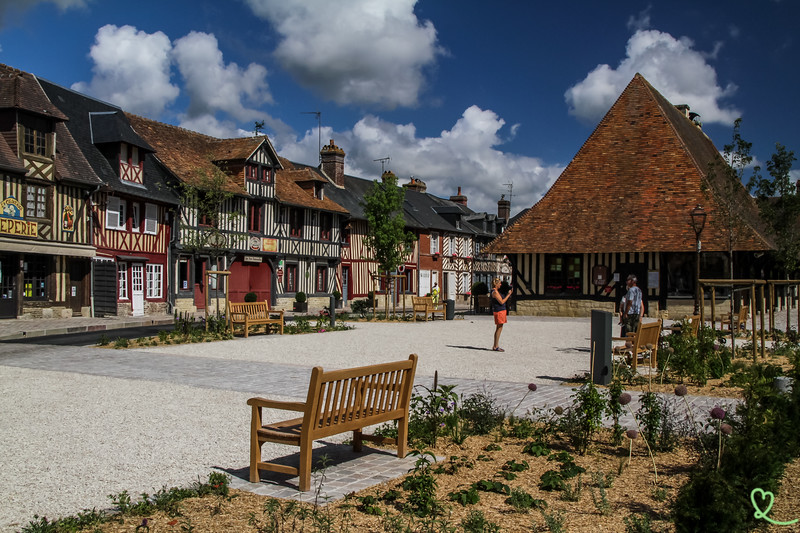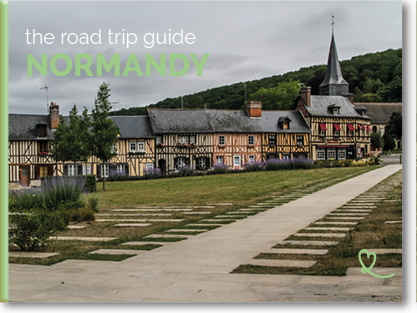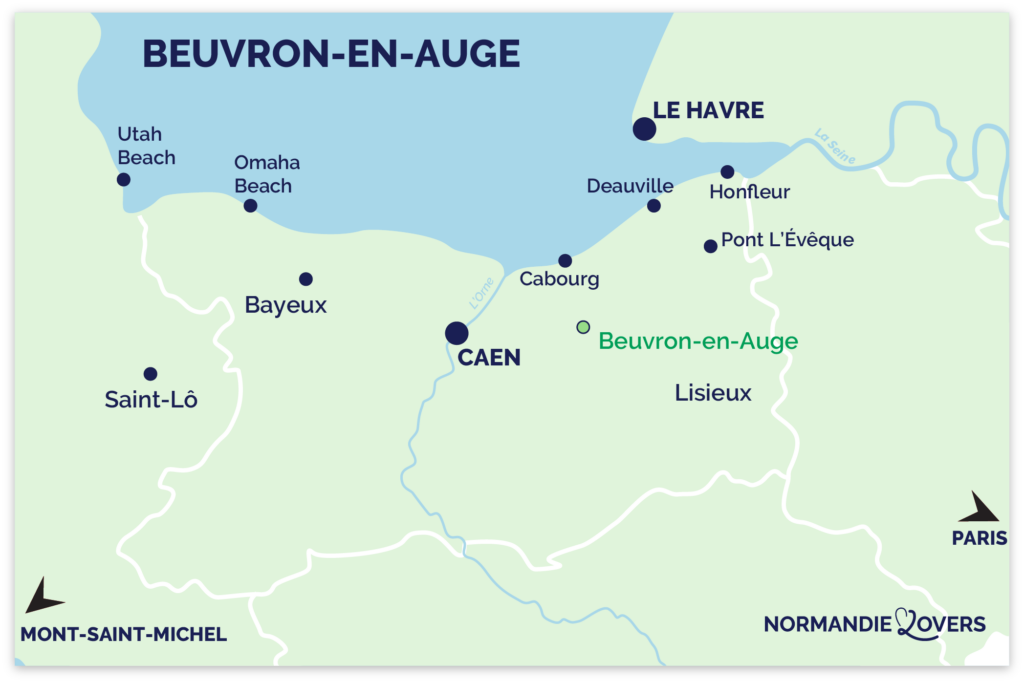If you’re exploring Deauville, Cabourg and Caen, don’t miss the charming little village of Beuvron-en-Auge. It’s one of Normandy’s best-known towns, with its streets filled with half-timbered houses surrounding a market hall.
Here’s our guide to the must-see attractions in the Normandy village of Beuvron-en-Auge, and some useful tips for planning your visit.

This guide is completely independent, based on our experiences. We visited the region anonymously, making our own choices and paying our bills in full.
Is the village of Beuvron-en-Auge worth a visit?
Absolutely. Beuvron-en-Auge offers authentic charm with its half-timbered houses, historic manor houses, waterways and picturesque atmosphere. Located on the Route du Cidre, it’s a must-see destination for discovering the essence of the Pays d’Auge. One of France’s most beautiful villages
It’s one of the most beautiful villages in Normandy, and a must-see in the region.
1. Historical center

Beuvron-en-Auge is not known for any particular building, but for its narrow streets and central square, where the historic houses were not destroyed by the Second World War. Apart from the asphalt road and the passing cars, the architecture takes you on a journey back in time.
Here’s a short summary of the village’s history:
Beuvron-en-Auge’s origins probably date back to Gallo-Roman times. The name “Beuvron” appears in other forms in documents as early as the 11th century.
In the 12th century, a small rural community was established. For several centuries, until the end of the 18th century, the Beuvron lands belonged to the powerful d’Harcourt family, who contributed greatly to the village’s economic development.
The town’s development accelerated in the 15th century and reached its peak in the 17th and 18th centuries, when tanning and weaving ensured the village’s prosperity.
2. Half-timbered houses

The village of Beuvron offers one of the finest examples of half-timbered architecture in Normandy and France. Where some towns have just a few houses, or just one street, Beuvron has several streets where the houses are all half-timbered. Perfect for photos!

Their facades are timber-framed, with straight or crossed half-timbering, filled with cob mixed with straw, bauge or pisé, and often decorated with small bricks, as you can see in the photo above.
These houses, mainly dating from the 17th and 18th centuries, have been carefully restored to preserve their authenticity.
USE OUR GUIDE TO PLAN A
DREAM TRIP TO Normandy
All the information you need for your trip:
- 8 maps that make planning easier
- 160+ pre-selected locations
- Practical advice
- 300+ photos to help you choose

2. Medieval” hall

In the heart of the main square, between the streets of half-timbered houses, you can’t miss the imposing building with its long, sloping roof (boat hull frame). This is the so-called medieval hall.
Today’s market hall is not truly medieval, but a relatively recent reconstruction inspired by traditional architecture. The original hall, built in 1850, was demolished in 1958.
The hall in front of you dates back to 1875, but it was built using traditional materials and techniques. It’s imposing in size, but we haven’t found any precise information on its dimensions.
This market hall hosts a Saturday morning market.
3. Historic manor houses and sculptures

In addition to small half-timbered houses, you’ll also find more imposing buildings.
As you walk from the tourist office to the main square, you can’t miss the half-timbered manor house in the photo above. It’s very impressive. It’s neither the Manoir du Lieu Hocquart, nor the Manoir de la Hogue as many sites suggest. Some call it the “Manoir de l’avenue de la Gare” or the “Manoir de Beuvron-en-Auge”. We couldn’t find any other names.

It dates back to the 15th century. But it has been reworked several times. The eastern part is the most historic.
Note the woodwork with the small sculptures.
The other mansions are outside the town:
- Manoir du Lieu Hocquart, dating from the 17th and 18th centuries (outside, north of the village – GPS 49°12′02″N, 0°03′10″W) – private property
- Manoir de la Hogue (outside, east of the village – GPS 49°11′30″N, 0°02′11″W) – private property
USE OUR GUIDE TO PLAN A
DREAM TRIP TO Normandy
All the information you need for your trip:
- 8 maps that make planning easier
- 160+ pre-selected locations
- Practical advice
- 300+ photos to help you choose

4. Le-Doigt River

A small river also runs through the heart of the village. You can admire it as you cross small bridges or walk around it.
One theory about the village’s name, according to René Lepelley, is that Beuvron was one of a number of names used to designate a watercourse (based on the Gallic word biber, meaning beaver).
The Le-Doigt river is a tributary of the Dives. Its overall length is 14.1m
5. Street names

Don’t just walk around the main square, discover the small alley to the east. And above all, read his name. The French will laugh at the sound, and foreigners at the impossibility of pronouncing it.
The photo above shows “Rue de la Catouillette”.

The perspective is charming, with a mix of stone and half-timbered walls.
The house in the center is interesting, with one half on stilts.
This street name is much funnier than Avenue de la Gare…
And if you’re wondering why the main square is called Place Michel Vermughen, it’s to pay tribute to its former mayor.
WHERE TO STAY IN Normandy
We particularly appreciate staying in Normandy:
- Bayeux – our hotels selection
- Honfleur – our hotel selection

For more ideas, take a look at our article on the best places to stay in Normandy.
And if you already have an idea, take a look at our selections:
6. The Cider Route

The Route du Cidre offers a charming experience of the region, combining architectural heritage, picturesque landscapes and local gastronomy. It allows you to discover some twenty cider producers in the region, indicated by the sign “Cru de Cambremer”..
Beuvron-en-Auge is one of the main villages on the Route du Cidre, alongside Cambremer, Bonnebosq and Beaufour-Druval..
In Beuvron-en-Auge, the DENIS and DESVOYE producers’ store offers local cider products such as cider, perry and calvados.
7. Other attractions in Beuvron-en-Auge
We’ve listed the main points of interest in the village, but you can also discover more:
- Saint-Martin church, originally built in the 17th century (north of the main square). with its central red-brick tower and white exterior.
- The Tourist Office to find out more about the region
- Artists’ and craftsmen’s workshops (ceramics, wood…)
- …
8. Attractions in the area

You can combine a visit to Beuvron with..:
- The magnificent Château de Crève-Coeur with its half-timbered buildings (12 min drive) – one of the most beautiful châteaux in Normandy.
- The seaside resort of Cabourg with its beautiful Belle-Époque villas (18min drive) – see attractions
- The famous seaside resort of Deauville, famous for its film festival and luxury boutiques (30 min. drive) – see attractions
- Sword Beach (a 35-minute drive from Ouistreham), one of the D-Day landing beaches, with its museums.
Subscribe to our Newsletter
- Get away from it all with Region Lovers’ beautiful destinations!
- Once a month
- Advertising-free
How to get to Beuvron-en-Auge + parking
Where to find Beuvron-en-Auge in Normandy
- In the Pays d’Auge region
- Between Cane and Deauville
- Deauville to Beuvron-en-Auge = 35 min driving time
- Caen to Beuvron-en-Auge = 35 min
- Paris to Beuvron-en-Auge = 2h45

How to get there
Beuvron-en-Auge is not accessible by public transport.
You’ll need a car.
The village is easy to reach. No difficult roads.
Parking in Beuvron-en-Auge
The advantage is that a very large parking lot has been created outside the village, next to the tourist office. It’s very practical, but only for vehicles under 2m.
Free at last count.
The caravan park is a little further west.

Useful tips
How long and when?
We recommend you allow an hour to wander around the village.
If you want to avoid the crowds, visit early in the morning or at the end of the day.
Tour directions, map and difficulty
No problem.
From the parking lot, it’s an easy 5-minute walk to the main square.
The floor is flat and well-maintained
Restaurants
There are several restaurants and cafés.
- The L’orée du village café has a terrace in front of a beautiful building.
- Pizza at La Piazza restaurant
- Pancakes at Restaurant La Colmb’Auge
- Restaurant Le Pavé d’auge, more traditional, at the end of Les Halles
PLAN YOUR TRIP TO Normandy
Inspiration destinations
- Deciding where to go in Normandy – the best destinations
- Our weekend ideas: best-of, romantic, unusual, seaside, luxury, family
- 16 seaside hotels in Normandy
- The most beautiful charming hotels in Normandy

Best of

Practice
- Where to stay in Normandy – best places and hotels
- See our tips for renting a car at CDG airport, Orly airport, Beauvais airport, Caen, Rouen, Bayeux…





